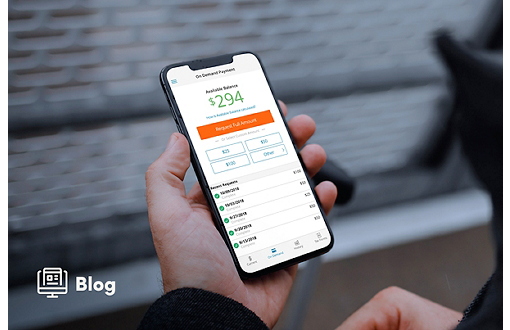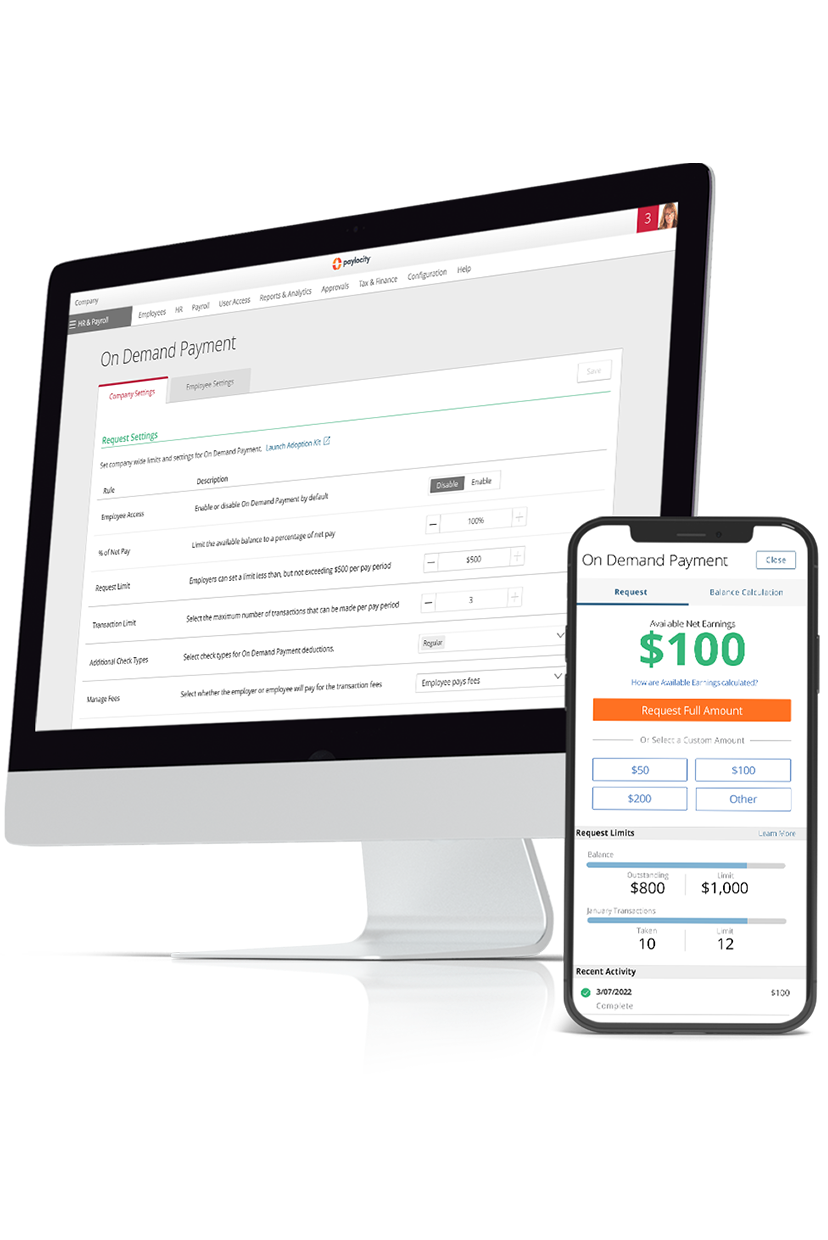resources
What is On Demand Pay? The Benefits of Flexible Pay Schedules
April 02, 2024
Let employees choose when they're paid. Learn how on demand payroll services benefit employees and employers.
Blog Post

Skip to end of table of contents
Table of Contents
- What Is On Demand Pay?
- How Does On Demand Pay Work?
- The Benefits of On Demand Payroll for Employees
- The Benefits of On Demand Payroll for Employers
- Challenges of On Demand Pay
- Staying Compliant with On Demand Payroll
- Choosing a Solution for On Demand Pay: Key Considerations
- Is On Demand Payroll Right for Your Business?
Have you considered adding earned wage access, also known as on demand pay, to your employee offerings?
On demand pay allows workers to request part of their paycheck before the next pay period – an appealing benefit, especially for employees who may be dealing with an unexpected expense. And with two-thirds of Americans living paycheck to paycheck, an expedited payday can help relieve some financial stress.
A 2022 CNBC survey uncovered that 70% of Americans are stressed about their finances. For employers, personal financial stress can have serious impacts on employee morale and productivity.
What can your company do to help employees manage personal financial strain? On demand pay is one strategy that many companies find helpful in supporting their staff.
Key Takeaways
- On demand pay offers immediate access to earned wages, helping employees manage unexpected expenses, avoid late fees, and reduce the necessity for high-interest loans.
- For employers, on demand payroll services serve as a competitive advantage in talent acquisition and can lower turnover rates.
- State and federal regulations around earned wage access continue to evolve. Employers must stay informed about legislative developments or partner with an on demand payment provider with compliance expertise.
What Is On Demand Pay?
On demand pay allows your employees to access earned wages when they need them. Your pay cycle stays the same, but employees can access funds they've already earned at any point. Instead of waiting for their next paycheck, or putting necessities on high-interest credit lines, an employee can access the amount of money they've already earned when they need it as on demand wages.
On demand payroll services can give employees more control over their finances and act as a safety net for employees when they need it. Once the employer approves the requested wages, the payment is executed automatically — often on the same day, without extra paperwork. Even better, you don’t have to worry about re-calculating their payroll.
How Does On Demand Pay Work?
With on demand pay, your staff can request earned wages through an employee self-service portal at any point (and typically through an HR mobile app) during the pay period. Within the Paylocity platform, on demand payment is managed through the payroll system, so taxes and legal requirements are all handled without any extra work for the company or HR department. As the employer, you won’t need to worry about cash flow issues, managing deductions, or payroll errors with this feature.
There's typically a low fee charged to the employee every time they make an early withdrawal of wages. However, Paylocity’s on demand payroll service provides the option for the employer to pay the fee if they choose.
The Benefits of On Demand Payroll for Employees
Your staff’s financial wellness should be considered when determining your benefits package, as employees who have financial stress are less productive and more likely to look for other jobs. Here are some of the ways that offering payment on demand can benefit employees:
1. Reduced Likelihood for Late Fees
Paying bills on time is an important aspect of financial security. Did you know 47 million Americans expected to miss a credit card payment in 2022? For many Americans who live paycheck to paycheck, one extra expense can mean missing bills and due dates.
On demand pay lets employees withdraw what they need when an unexpected expense crops up, which can help them avoid costly late fees.
2. Assistance with Unexpected Costs
Things go wrong. Cars break down, houses need repairs, and there are unplanned medical bills. There are all sorts of extra expenses that your employees may not have budgeted for.
Being able to withdraw pay on demand for an emergency can help your employee tap into resources when needed. With on demand payment, employees may have less stress over where to find money or how to do without things they may need.
3. Reduced Need for Bad Loans
Workers who live paycheck to paycheck could feel more pressure to take out loans with high-interest rates to support their expenses. Being able to access current earnings with on demand pay can help them budget and avoid high-interest loans.
4. Helping Employees Feel Supported
For employees, the ability to access their wages on demand is a significant benefit of employment. They don't need to use the feature if they don't want to, but it's available if they ever have the need. This level of support provides an extra layer of security.
For additional support, consider offering financial literacy training for employees to manage this feature for their best benefit.
Learn More: The 14 Best Employee Benefits to Dazzle Your Talent
The Benefits of On Demand Payroll for Employers
Offering on demand payroll services is a way to help employees manage their personal finances and alleviate some day-to-day stress. Let’s explore how offering this type of benefit can help employers as well:
1. Showcases the Employer's Investment in Employees
On demand payroll is a means of offering financial support and flexibility, which directly impacts an employee’s well-being. Offering these types of benefits showcases that your organization is invested in your employees, which in turn can improve morale and company culture.
2. Serves as a Competitive Benefit for Attracting Talent
It’s no surprise that benefits can sway potential new hires one way or another. A recent Gallup poll found that 64% of workers say an increase in pay or benefits is very important to them when accepting a new job. Offering on demand wages is an effective benefit that attracts top talent as a key differentiator in a competitive labor market. Be sure to highlight on demand payment options during the recruiting and hiring process, while also reminding current employees to take advantage of the service as needed.
3. Happier and More Productive Employees
Employers can also benefit from a workforce that feels supported by the flexibility of on demand pay offerings. When employees have support systems in place to help deal with unexpected expenses, they may be better positioned to cope with financial stress so they can focus on their performance and productivity.
4. Better Retention and Reduced Turnover
According to a PwC 2022 employee wellness survey, financially stressed employees are twice as likely to look for a new job. Financial options like on demand pay can provide more support to workers dealing with cash or debt problems, which may deter them from seeking a new position. For the employer, this means better retention and reduced employee turnover.
The Best Candidates for On Demand Pay
While any employer can benefit from offering earned wage access, on demand pay is particularly appealing to organizations that must compete in the gig economy, which relies heavily on temporary and part-time workers.
The gig economy is growing strong, with 36% of Americans identifying as independent, or gig, workers.
What's the draw? For many, it's same-day or faster payment.
Sectors that experience high turnover rates, like food service, hospitality, or logistics, and are face talent losses to gig opportunities, on demand pay could provide the competitive advantage necessary to attract and retain employees.
Challenges of On Demand Pay
Payroll processing can be a time-consuming and complicated process for employers. Adding functionality like on demand payment, while coming with the above benefits, can add certain challenges to this process.
1. Fees Per Transaction
One primary challenge of on demand pay is that transactions often come with fees (although, as previously mentioned, Paylocity gives employers the option to cover this). Employers should ensure all employees are aware of these fees so that they’re not surprised when on demand payments are requested.
That said, on demand transaction fees are typically much lower than those associated with overdrafts, late payment fees, or payday loans, so many employees prefer the on demand fees over other options.
2. Financial Stability
For a business, on demand pay schedules can present challenges for payroll, cash flow, and liquidity. With employees able to withdraw funds whenever they need to, businesses have to plan payroll carefully and in advance.
There are two major considerations: Your overall staffing costs and maintaining liquidity and flexibility to facilitate sporadic payments. You need to ensure methods are in place to enable multiple smaller transactions without accumulating unnecessary processing fees.
For employees, on demand pay offers a level of financial stability that traditional payroll processing can't match. Employees can receive their wages when they need them, rather than waiting for their next paycheck. However, employees who don’t have experience with budgeting can misuse the feature.
3. Constructive Receipt
Another complication of on demand pay is the concept of constructive receipt, which can impact the timing of tax withholdings depending on the company’s payday and deposit schedules as well as local tax regulations. Under constructive receipt, employees and employers may be exposed to additional tax liabilities.
Staying Compliant with On Demand Payroll
On demand payroll is subject to state and federal payroll regulations, and the legal landscape evolves as individual states trial new legislation.
While the federal government has yet to enact laws specifically governing earned wage access, the introduction of the Earned Wage Access Consumer Protection Act in February 2024 marks a significant step toward defining and regulating on demand payment programs. This proposed legislation aims to establish clear guidelines and required disclosures for these programs.
At the state level, the legal framework is gradually taking shape. Wisconsin, Nevada, and Missouri are the only states that have enacted laws that outline on demand pay policies. These states, along with four others considering similar measures, are focused on safeguarding employees against hidden fees and unnecessary credit inquiries.
Ultimately, employers need to operate within the confines of legislative requirements to ensure on demand payroll compliance.
To help support employers, Paylocity handles on demand payroll within the platform, which means legal stipulations are embedded and continuously updated in the system, requiring no additional labor from employers or HR professionals.
Choosing a Solution for On Demand Pay: Key Considerations
Like any major business decision, you need to carefully assess your options when it comes to choosing an on demand pay solution. There are several important factors to consider.
1. How Scalable is my On Demand Pay Solution?
It's crucial that the solution you choose is can scale with your business. A potential partner might look good now, but will they still be the perfect fit when your business starts to grow and expand? Some on demand pay programs are intertwined with specific payroll systems. This can mean you have to start the process all over again if you want to upgrade or add features to meet your changing workforce needs
2. How Robust Is the Product?
When choosing an on demand pay solution for your business, you want something reliable, secure, high-speed, and, above all else, makes your employees’ lives easier. It’s important to ensure you have a clear picture of all the tools and features included with your solution.
Just as important is the level of support the vendor offers. You don’t want to pay for a solution, particularly where finances are concerned, without a high degree of confidence that any issues will be resolved quickly.
3. Security and Data Privacy
It is paramount that your data privacy is protected. Your on demand pay solution should treat security with the gravity it deserves. Does your potential partner regularly test its security program? Make sure you’re confident in their ability to manage your critical business information.
Is On Demand Payroll Right for Your Business?
Payroll on demand can benefit all types of employees, and small businesses in particular benefit from on demand payroll services. When budgets are tight and there’s a lot on HR’s shoulders, offering a flexible payment option can help improve retention by providing additional financial stability when raising wages isn’t feasible.
Additionally, in industries where attracting and retaining talent is of particular concern, on demand payment can be a way to stand out from the competition. And as employees are not just leaving jobs but switching from one industry to another, the stakes are higher.
In fact, the consumer and retail industry sees the highest numbers of employees who have left positions and the industry for new roles. Offering rapid on demand pay can be a meaningful differentiator within your benefits package that attracts quality candidates and helps keep your existing employees on board.
Employees and employers across industries have learned the value of services like on demand pay. It can serve as a standout feature when labor market fluctuations persist, and your employees will thank you for it.
Request a payroll demo from Paylocity today to learn more about our on demand payment feature!

Any Day Can Be Pay Day
Unexpected expenses happen. And they don’t wait for pay day. When your employees need an immediate cash flow option, our On Demand Payment gives them flexible access to their earned wages without interrupting your payroll process. Your workforce can do this directly from our mobile app. That means there’s no added paperwork for you – and it helps employees satisfied in a competitive market.


